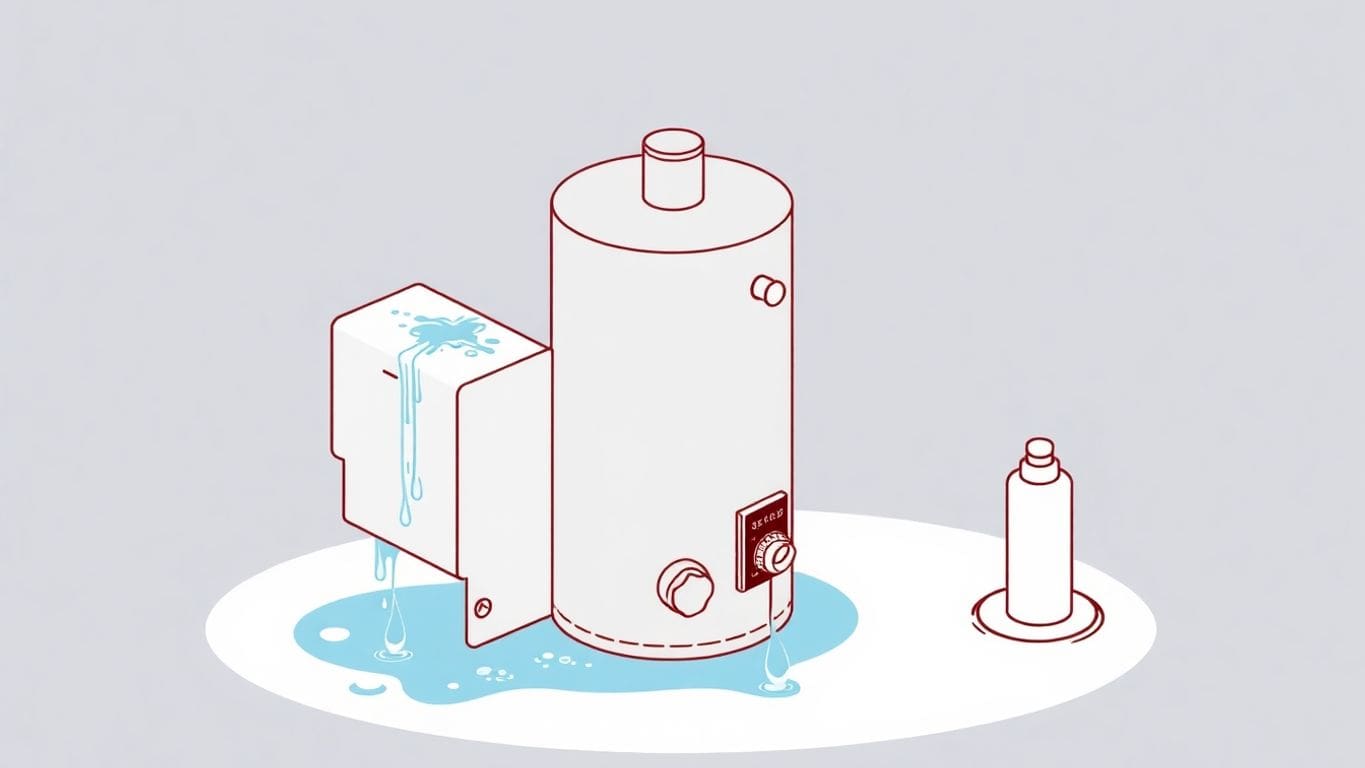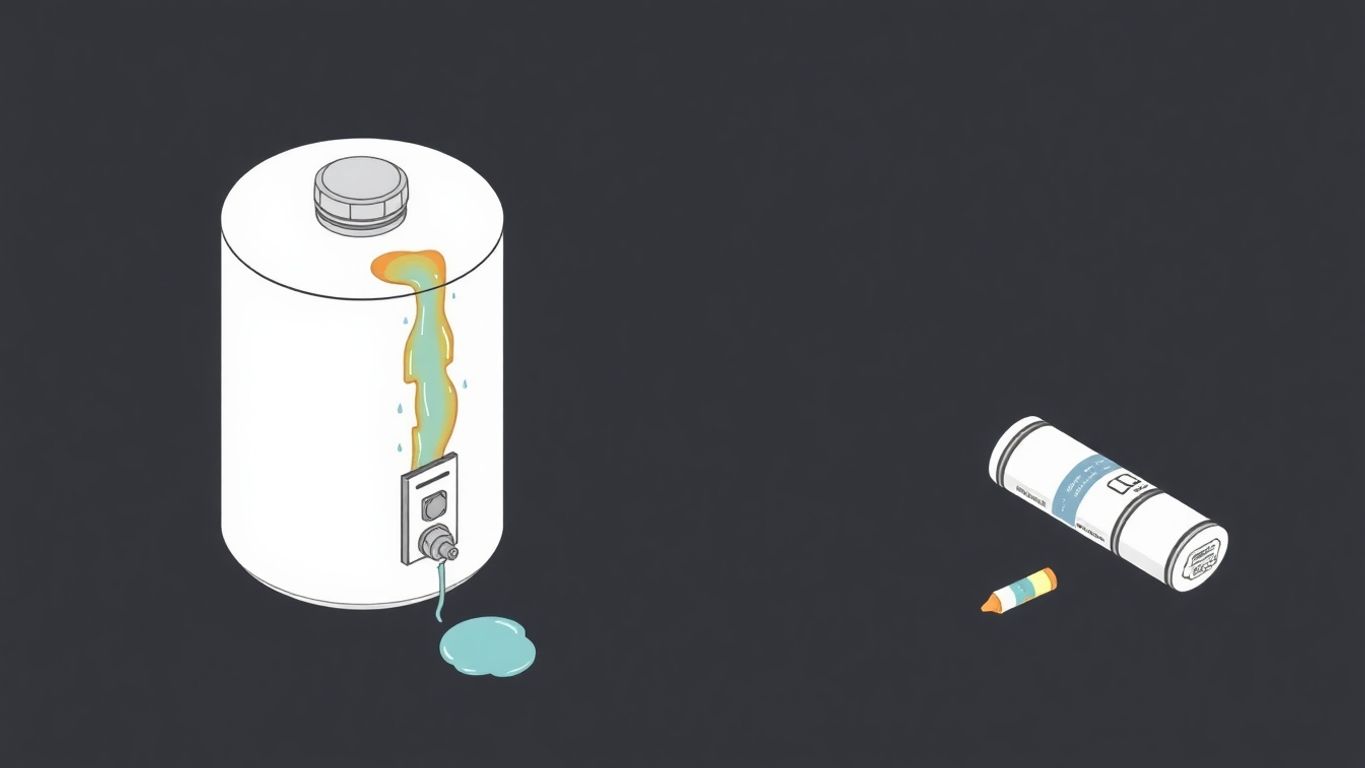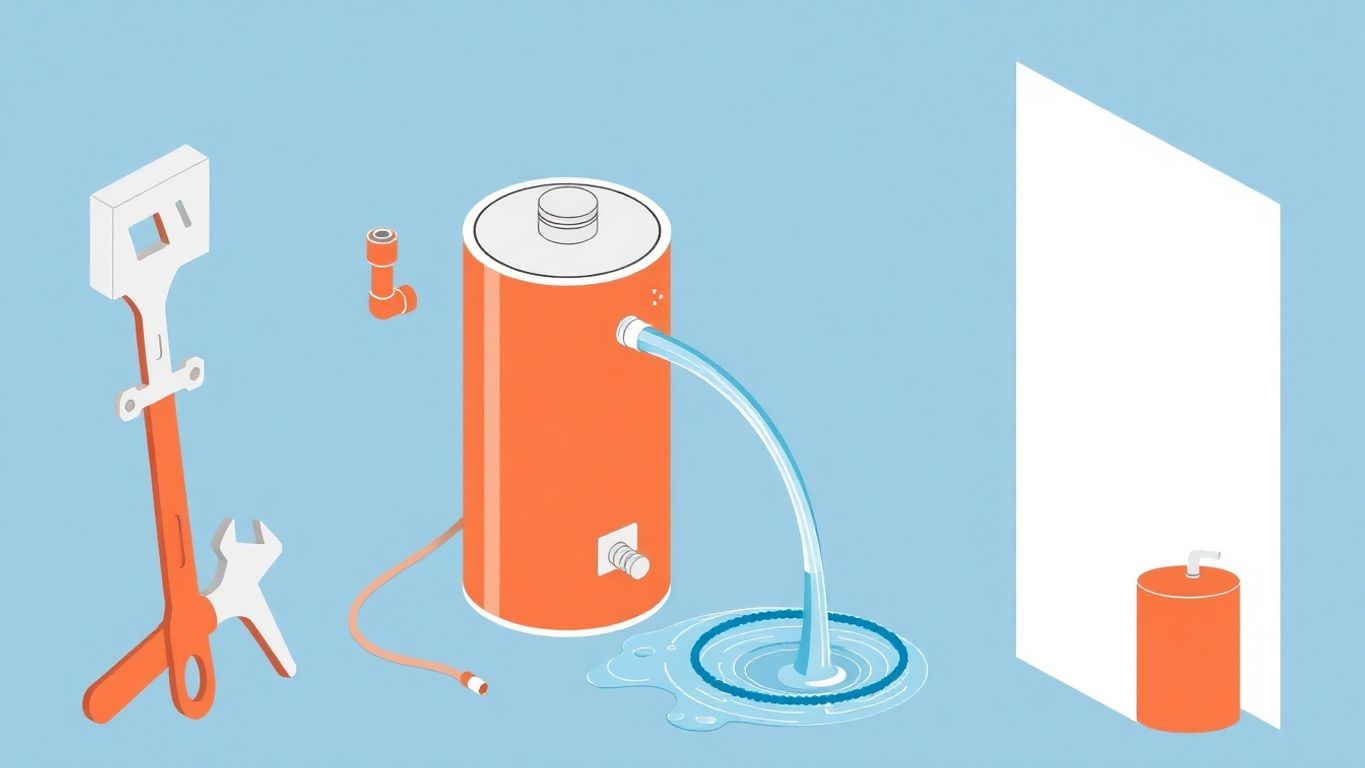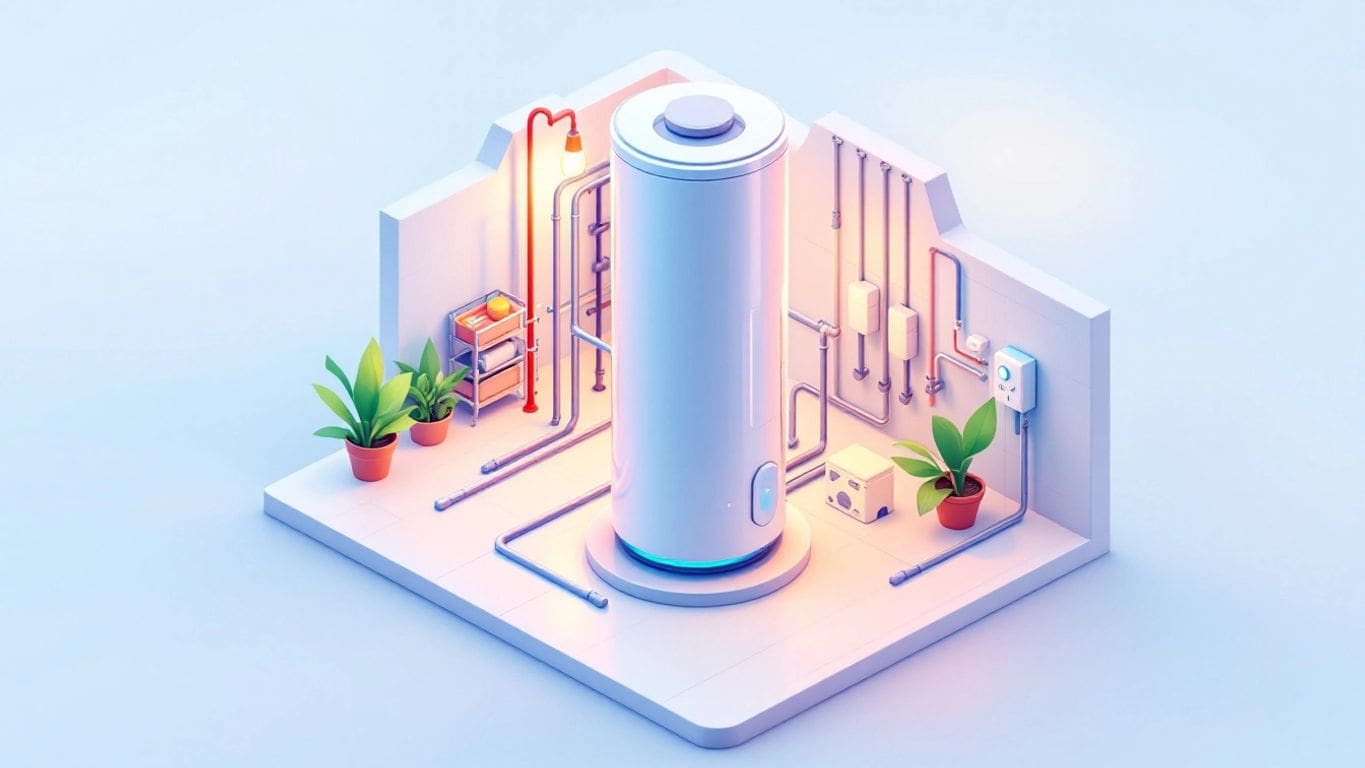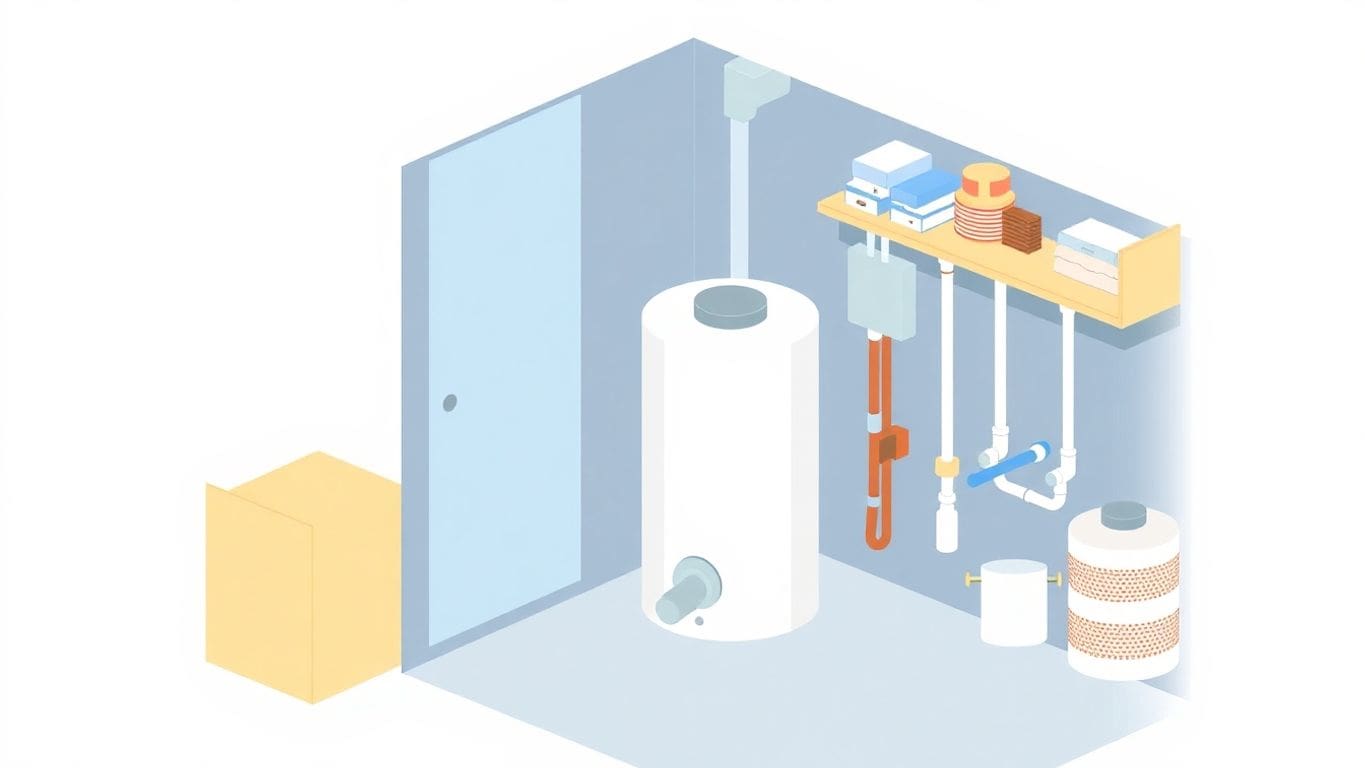Water heaters are essential for our daily routines, providing hot water for showers, cleaning, and cooking. When they start acting up, it can be a real hassle. Before you reach for the phone to call a plumber, consider tackling the problem yourself. This guide will walk you through the basics of how to repair a water heater, covering everything from identifying issues to performing repairs safely. You might be surprised at how much you can do on your own!
Key Takeaways
- Understand the main parts of your water heater and how they work.
- Always prioritize safety by turning off power and water before starting repairs.
- Common issues include no hot water, leaks, and strange noises.
- Regular maintenance, like flushing the tank, can prevent many problems.
- Know when it’s time to call a professional for help.
Understanding Your Water Heater Components
Before you start fixing your water heater, it’s good to know what all the parts do. This will help you figure out what’s wrong and how to fix it. Think of it like learning the names of the tools in your toolbox before you start a project.
Key Parts of a Water Heater
Your water heater has a few main parts that all work together. Knowing these parts will help you understand how your water heater works. Here are some of the most important parts:
- Tank: This is the big container that holds the water. It’s usually insulated to keep the water hot.
- Heating elements: These heat the water inside the tank. Electric water heaters usually have two.
- Thermostat: This controls the temperature of the water. It turns the heating elements on and off to keep the water at the right temperature.
- Anode rod: This protects the tank from rusting. It’s a metal rod that attracts corrosive elements in the water.
- Pressure relief valve: This valve releases pressure if it gets too high inside the tank. It’s a safety feature to prevent explosions.
- Drain valve: This is used to drain the water from the tank, usually for maintenance or repairs.
How Each Component Works
Each part of your water heater has a specific job. Here’s a simple explanation of how they work together:
- Cold water enters the tank through a pipe at the top or bottom.
- The heating elements turn on and heat the water. The heating elements are controlled by the thermostats.
- The thermostat monitors the water temperature and turns the heating elements off when the water reaches the set temperature.
- The anode rod protects the tank from corrosion by attracting corrosive elements.
- When you turn on a hot water tap, hot water is pushed out of the tank and through the pipes to your faucet.
- If the pressure inside the tank gets too high, the pressure relief valve opens to release some of the pressure.
Understanding how each part works will make it easier to diagnose problems and make repairs. It’s like knowing how an engine works before you try to fix your car.
Common Issues with Components
Like any appliance, water heater parts can have problems. Here are some common issues:
- Heating elements: Can burn out or become covered in mineral buildup, which makes them less efficient.
- Thermostat: Can fail and cause the water to be too hot or too cold.
- Anode rod: Can corrode and need to be replaced to protect the tank.
- Pressure relief valve: Can leak or fail to open when needed.
- Tank: Can rust and leak, especially if the anode rod is not working properly.
Knowing these common problems can help you figure out what’s wrong with your water heater. Regular checks and maintenance can help prevent these issues and extend the life of your water heater.
Essential Safety Precautions
Fixing a water heater can be dangerous if you don’t take the right steps. It’s super important to be careful and follow these safety rules to keep yourself safe.
Turning Off Power and Water
Before you even think about touching your water heater, turn off the power. Find the right circuit breaker in your electrical panel and switch it off. Use a non-contact voltage tester to double-check that the power is really off. Next, turn off the water supply to the heater. There should be a valve on the cold water pipe leading to the tank. Close it tightly.
Using Protective Gear
Protect yourself! Wear safety glasses to keep stuff out of your eyes. Gloves are a good idea too, especially when dealing with hot water or rusty parts. If you’re working in a damp area, wear rubber boots to avoid getting shocked.
Identifying Hazards
Look around for anything that could be dangerous. Is there water on the floor? That’s a slip hazard! Are there any exposed wires? Stay away! Water heaters can be heavy, so be careful when moving around them. Also, be aware of hot surfaces. Give the water heater time to cool down before you start working on it. Here’s a list of common hazards:
- Electrical Shock: Always turn off power first.
- Scalding: Hot water can burn you quickly.
- Heavy Lifting: Get help if you need to move something heavy.
- Gas Leaks: If you smell gas, leave immediately and call for help.
Working with water and electricity can be risky. If you’re not comfortable with any of these steps, it’s always best to call a professional plumber. They have the training and experience to do the job safely.
Troubleshooting Common Water Heater Problems
It can be a pain when your water heater isn’t working right. Let’s look at some common problems and how you can try to fix them.
No Hot Water Issues
If you’re not getting any hot water, that’s a big problem! First, check your circuit breaker. It might have tripped. If the breaker is fine, the problem could be with the heating element or the thermostat. You can use a multimeter to check if the heating element is working. If it’s not, you’ll need to replace it. Thermostats can also go bad. If the water is too hot, the thermostat might be set too high or be faulty.
Strange Noises from the Heater
Is your water heater making weird noises? It could be a sign of sediment buildup. Sediment is like dirt and minerals that collect at the bottom of the tank. This can cause:
- Banging sounds
- Popping noises
- Whistling
To fix this, you’ll need to flush the water heater. Flushing removes the sediment. If the noises continue after flushing, there might be another problem, like a faulty heating element.
Water Leaks and Their Causes
Water leaks are never good. They can damage your home and waste water. Here’s what to look for:
- Check the connections: Look for leaks around the pipes connected to the water heater.
- Inspect the tank: If the tank itself is leaking, it might be corroded. This is a serious problem.
- Valves: Leaks can also come from the pressure relief valve or the drain valve.
If you find a leak, try to tighten the connections first. If that doesn’t work, you might need to replace the valve or, in the worst case, the entire water heater. If the tank is leaking, it’s probably time for a new one. Tanks can rust from the inside out, and there’s not much you can do to fix that.
Step-by-Step Guide to Repairing Heating Elements
Identifying a Faulty Heating Element
So, you think your heating element is bad? First, you need to make sure that’s really the problem. If your water isn’t getting hot, or it’s only lukewarm, a bad heating element could be the reason.
- Turn off the power to the water heater at the breaker box. This is super important for safety!
- Remove the access panel on the side of the water heater. You might need a screwdriver.
- Take off the insulation covering the heating element. Be careful, it can be itchy.
- Use a multimeter to test the heating element for continuity. If you don’t get a reading, the element is likely bad.
Removing the Old Element
Okay, so you’ve confirmed the heating element is bad. Now it’s time to take it out. This can be a little tricky, but you can do it!
- Turn off the water supply to the water heater. There should be a valve on the cold water line going into the tank.
- Drain some water from the tank. You don’t need to drain the whole thing, just enough to get below the level of the heating element. Use the drain valve at the bottom of the tank and a garden hose.
- Disconnect the wires from the heating element. Remember how they were connected, or take a picture!
- Use a heating element wrench to unscrew the old element. It might be tight, so put some muscle into it. Be ready for a little more water to come out.
Installing a New Heating Element
Alright, you’re almost there! Now it’s time to put in the new heating element and get your hot water back. Make sure the new element has the same wattage and voltage as the old one.
- Wrap the threads of the new heating element with plumber’s tape. This helps prevent leaks.
- Screw the new heating element into the tank using the heating element wrench. Tighten it snugly, but don’t overtighten.
- Reconnect the wires to the heating element. Make sure they’re secure.
- Put the insulation back in place and reattach the access panel.
- Turn the water supply back on and let the tank fill up. Check for leaks around the heating element.
- Turn the power back on at the breaker box. Wait a few hours for the water to heat up, and enjoy your hot shower!
Fixing Leaks in Your Water Heater

Leaks can be scary! Water damage is no joke. Let’s figure out how to handle those pesky water heater leaks.
Identifying the Source of the Leak
First, find where the water is coming from. Is it a small drip or a steady stream? Check these spots:
- The top of the heater: Look for leaks around the cold water inlet or the hot water outlet.
- The bottom of the heater: This could mean the tank itself is leaking, which is a bigger problem.
- Around the pressure relief valve: This valve releases pressure, but it shouldn’t leak constantly.
- Pipes and connections: Check where pipes connect to the heater for any drips.
Sometimes, what looks like a leak is just condensation. Condensation is when water vapor turns into liquid on the cold surface of the tank. If it’s condensation, the tank will be wet all over, not just in one spot.
Temporary Fixes for Leaks
Okay, you found the leak. Now what? Here are some quick fixes to try:
- Tighten Connections: Use a wrench to gently tighten any loose connections or inlet pipes. Don’t overtighten, or you could damage the parts.
- Replace the Pressure Relief Valve: If the valve is leaking, you might need a new one. These are cheap and easy to replace.
- Use Plumber’s Tape: Wrap plumber’s tape around threaded connections to seal small leaks. This is a good temporary fix.
Remember, these are temporary fixes. If the leak is serious, you’ll need to do more than just patch it up.
When to Replace the Tank
Sometimes, a leak means it’s time for a new water heater. Here’s when you should consider replacing the whole unit:
- The tank itself is leaking: If the tank is rusted through and leaking, it can’t be fixed. Time for a new one.
- The heater is old: Water heaters usually last 10-15 years. If yours is older, a leak could be a sign it’s failing. It might be time to start budgeting for a new water heater.
- You’ve tried everything else: If you’ve tried fixing the leak and it keeps coming back, it’s probably time to replace the heater. It’s better to replace it before it fails completely and causes a flood.
| Issue |
Solution |
| Loose Connection |
Tighten with a wrench |
| Leaking Relief Valve |
Replace the valve |
| Tank Leak |
Replace the entire water heater |
| Old Water Heater (10+ years) |
Consider replacing before total failure |
Flushing Your Water Heater for Maintenance

Over time, stuff builds up in your water heater. This stuff is mostly sediment, like minerals and dirt that come in with your water. Flushing your water heater helps get rid of this sediment and keeps your heater working well. It’s like giving your water heater a good cleaning!
Why Flushing is Important
Flushing your water heater is important for a few reasons:
- It gets rid of sediment that can make your water heater less efficient.
- It can help your water heater last longer.
- It can stop weird noises from coming from your water heater.
If you don’t flush your water heater, the sediment can build up and make it harder for the heater to heat water. This means you’ll use more energy and your water heater might break down sooner. Plus, all that sediment can make your hot water look dirty or smell funny.
How to Flush Your Water Heater
Here’s how to flush your water heater. It sounds hard, but it’s not too bad if you follow these steps:
- Turn off the power to your water heater. For an electric heater, flip the breaker. For a gas heater, turn the gas valve to "off."
- Turn off the cold water supply to the water heater.
- Connect a garden hose to the drain valve at the bottom of the water heater.
- Put the other end of the hose outside or in a drain where the water can drain safely.
- Open the drain valve and let the water drain out. It might take a while.
- Once the water is done draining, turn the cold water supply back on for a few minutes to flush out any remaining sediment.
- Turn off the cold water supply again and let the water drain out completely.
- Close the drain valve and disconnect the hose.
- Turn the cold water supply back on and let the tank fill up completely.
- Turn the power or gas back on to your water heater.
Flushing your water heater is a good idea to do at least once a year. It helps keep your water heater working well and lasting longer. It’s a simple thing you can do to avoid bigger problems later on.
Signs You Need to Flush
How do you know when it’s time to flush your water heater? Here are some signs:
- Your hot water looks dirty or rusty.
- Your water heater is making strange noises, like popping or banging.
- Your hot water isn’t as hot as it used to be.
- It’s been more than a year since you last flushed it.
If you notice any of these signs, it’s a good idea to flush your water heater soon. It’s a simple way to keep your water heater in good shape!
Replacing the Thermostat in Your Water Heater
Your water heater’s thermostat is like the brain that controls the temperature. If it’s not working right, you might not get hot water, or the water could be too hot. Luckily, replacing it is something you can do yourself with a few simple steps.
Symptoms of a Faulty Thermostat
How do you know if your thermostat is bad? Here are some common signs:
- No hot water at all: This is a big clue that something is wrong, and the thermostat could be the problem.
- Water that’s not hot enough: If your water is lukewarm, the thermostat might not be reading the temperature correctly.
- Water that’s too hot: If the water is scalding, the thermostat might not be regulating the temperature properly.
- Big changes in water temperature: If the water temperature goes up and down a lot, the thermostat could be failing.
Replacing the thermostat is often a simple and inexpensive fix. It’s worth trying before you call a plumber. A new thermostat typically costs around $20, making it an affordable solution to try.
Steps to Replace the Thermostat
Here’s how to replace the thermostat in your water heater. Remember to be safe and turn off the power first!
- Turn off the power: Go to your circuit breaker and turn off the breaker for the water heater. This is super important for safety.
- Remove the access panel: Use a screwdriver to take off the panel covering the thermostat. You might need to remove some insulation.
- Take a picture: Before you disconnect any wires, take a photo of how they’re connected. This will help you remember where everything goes when you put the new thermostat in.
- Disconnect the wires: Carefully disconnect the wires from the old thermostat. Use pliers if needed.
- Remove the old thermostat: Take out the old thermostat. It might be held in place by clips or screws.
- Install the new thermostat: Put the new thermostat in the same way the old one was. Make sure it’s secure.
- Reconnect the wires: Use your photo to reconnect the wires to the new thermostat. Make sure the connections are tight.
- Replace the access panel: Put the insulation back in place and screw the access panel back on.
- Turn the power back on: Go back to the circuit breaker and turn the power back on.
Testing the New Thermostat
After you replace the thermostat, you need to make sure it’s working right. Here’s how:
- Wait and see: Give the water heater some time to heat up the water. This could take an hour or two.
- Check the water temperature: Turn on a hot water faucet and check the temperature. It should be hot, but not scalding.
- Listen for the heater to cycle: You should hear the water heater turn on and off as it maintains the temperature. This means the thermostat is working. If you’re still having problems with your water heating systems, it might be time to call a professional.
Addressing Sediment Buildup
Over time, stuff in your water, like minerals, can settle at the bottom of your water heater. This is called sediment buildup. Too much sediment can cause problems, so it’s good to deal with it.
What is Sediment Buildup?
Sediment buildup is when minerals and other stuff in your water settle at the bottom of your water heater tank. It’s like the stuff that settles at the bottom of a fish tank. This sediment can make your water heater work harder and not as well. It can also cause noises like popping or rumbling.
How to Remove Sediment
To remove sediment, you need to flush your water heater. Here’s how:
- Turn off the power to your water heater. For electric heaters, flip the circuit breaker. For gas heaters, turn the gas valve to "off."
- Turn off the cold water supply to the heater.
- Attach a garden hose to the drain valve at the bottom of the tank.
- Put the other end of the hose outside or in a drain.
- Open the drain valve and let the water run until it’s clear. This might take a while.
- Close the drain valve and turn the cold water supply back on. Let the tank fill up.
- Turn the power back on to your water heater.
Flushing your water heater is a simple way to keep it running well. It helps get rid of sediment that can cause problems.
Preventing Future Buildup
Here are some things you can do to keep sediment from building up:
- Flush your water heater at least once a year.
- Consider getting a water softener if you have hard water. Hard water has more minerals that can cause sediment.
- Check your anode rod regularly. The anode rod helps prevent corrosion, and when it corrodes, it can add to the sediment in your tank.
Common Electric Water Heater Issues
Electric water heaters are pretty reliable, but sometimes things go wrong. Let’s look at some common problems you might run into with your electric water heater and how to deal with them. Remember to always turn off the power before you start poking around!
Tripped Circuit Breakers
One of the most common issues is a tripped circuit breaker. This happens when the water heater pulls too much power, causing the breaker to shut off as a safety measure. The first thing to do is check your breaker box.
- Reset the breaker: Find the breaker for your water heater. It will likely be labeled. Flip it all the way to the "off" position, and then back to "on".
- Check for other appliances: Make sure you aren’t running too many other high-power appliances on the same circuit. Things like hair dryers or space heaters can overload the circuit.
- If it keeps tripping: If the breaker trips again right away, there might be a bigger problem, like a short circuit in the water heater itself. You might need to call an electrician.
Faulty Wiring
Bad wiring can also cause problems with your electric water heater. Loose connections or damaged wires can prevent the heater from working right, or even create a fire hazard.
- Check the wiring: Turn off the power at the breaker! Then, take a look at the wiring connections to the water heater. Make sure all the wires are tightly connected and that there are no signs of damage, like burning or fraying.
- Tighten connections: If you find any loose connections, tighten them with a screwdriver. Be careful not to overtighten them.
- Replace damaged wires: If you see any damaged wires, replace them. You can buy replacement wires at most hardware stores. If you aren’t comfortable doing this yourself, call an electrician.
Faulty wiring is a serious issue that can lead to electrical fires. If you’re not comfortable working with electricity, it’s always best to call a professional.
Overheating Problems
Sometimes, an electric water heater can overheat. This can be caused by a faulty thermostat or sediment buildup in the tank. Overheating can be dangerous and can damage the water heater.
- Check the thermostat: The thermostat controls the temperature of the water. If it’s not working right, it might let the water get too hot. You can test the thermostat with a multimeter to see if it’s working. If it’s bad, replace it.
- Flush the tank: Sediment buildup can cause the heating elements to overheat. Flushing your water heater regularly can help prevent this. Follow the steps in the maintenance section to flush your tank.
- Lower the temperature setting: If your water is getting too hot, try lowering the temperature setting on the thermostat. A setting of 120°F is usually good.
Here’s a quick guide to common issues:
| Problem |
Possible Cause(s) |
Solution(s) |
| Tripped circuit breaker |
Overload, short circuit |
Reset breaker, check for other appliances, call an electrician |
| No hot water |
Faulty heating element, tripped breaker |
Replace heating element, reset breaker |
| Water too hot |
Faulty thermostat |
Replace thermostat, lower temperature setting |
| Strange noises |
Sediment buildup |
Flush the tank |
| Leaking |
Loose connections, corrosion, tank failure |
Tighten connections, replace valve, consider replacing the water heater |
When to Call a Professional
Sometimes, fixing your water heater yourself isn’t the best idea. There are times when you really need to call in a pro. It’s better to be safe than sorry, especially when dealing with gas, electricity, or water.
Signs You Need Expert Help
- No matter what you do, the water heater keeps leaking. If you’ve tried fixing a leak and it keeps coming back, it might be time to call a plumber. Persistent leaks can mean bigger problems inside the tank.
- You smell gas near your gas water heater. Gas leaks are super dangerous. If you smell gas, leave your house right away and call the gas company or a plumber from a safe place. Don’t try to fix it yourself!
- You’re not comfortable working with electricity. Water and electricity don’t mix. If you’re not sure how to safely work with electrical wires, call an electrician or a plumber who knows about electrical work.
- The water heater is making really weird noises. Some noises are normal, but loud banging, popping, or hissing could mean there’s a serious problem. It’s best to have a pro check it out.
- Your water is rusty or has a bad smell. This could mean there’s corrosion inside the tank or even bacteria in the water. A plumber can figure out what’s going on and fix it.
Trying to fix something you’re not sure about can make the problem worse or even dangerous. It’s always okay to ask for help from someone who knows what they’re doing.
Cost Considerations
Calling a plumber will cost money, but it can save you money in the long run. Here’s why:
- You might make the problem worse. If you mess up the repair, you could end up needing to replace the whole water heater, which is way more expensive.
- A pro can fix it right the first time. They have the tools and experience to diagnose the problem and fix it quickly and safely.
- They can spot other problems. A plumber might notice other issues with your plumbing that you didn’t see, which can save you from bigger problems later.
Finding a Reliable Plumber
Finding a good plumber is important. Here are some tips:
- Ask friends and family for recommendations. Word of mouth is a great way to find someone trustworthy.
- Read online reviews. See what other people are saying about plumbers in your area.
- Check if they’re licensed and insured. This protects you if something goes wrong during the repair.
- Get a few quotes. Call a few different plumbers and ask for estimates before you decide who to hire.
- Make sure they have experience with water heaters. Not all plumbers specialize in water heaters, so find one who does.
Maintaining Your Water Heater for Longevity
Taking care of your water heater can help it last longer. It’s like taking care of your car. If you do regular check-ups, it will run better for years. Let’s talk about how to keep your water heater in good shape.
Regular Maintenance Tips
- Flush your water heater at least once a year. This gets rid of sediment that can build up and cause problems. Sediment can make your water heater work harder and not heat water as well.
- Check the anode rod every few years. This rod helps prevent rust inside the tank. If it’s worn out, replace it.
- Look for any leaks around the water heater. Fix them quickly to prevent bigger problems.
Signs of Wear and Tear
Knowing what to look for can help you catch problems early. Here are some signs that your water heater might need attention:
- Less hot water than usual.
- Strange noises coming from the tank.
- Rusty or discolored water.
- Water leaking around the base of the heater.
If you notice any of these signs, it’s a good idea to check your water heater. Ignoring small problems can lead to bigger, more expensive repairs later.
Best Practices for Efficiency
Here are some things you can do to help your water heater run better and save energy:
- Set the thermostat to 120°F (49°C). This is usually hot enough for most people and saves energy.
- Insulate the hot water pipes. This helps keep the water hot as it travels through your house.
- Consider getting a water heater blanket. This wraps around the tank and helps keep the water warm, so the heater doesn’t have to work as hard.
| Practice |
Benefit |
| Lower Thermostat (120°F) |
Saves energy, prevents scalding |
| Insulate Pipes |
Reduces heat loss, saves energy |
| Annual Flushing |
Removes sediment, improves efficiency |
Frequently Asked Questions
How do I know if my water heater needs repairs?
If your water heater isn’t giving hot water, is leaking, or making strange noises, it might need repairs.
Can I fix my water heater myself?
Yes, many minor repairs can be done by yourself if you follow safety steps and instructions.
What are common problems with water heaters?
Common issues include no hot water, leaks, strange noises, and sediment buildup.
How often should I flush my water heater?
It’s a good idea to flush your water heater at least once a year to keep it clean.
What should I do if my water heater is leaking?
First, turn off the water supply and try to find the leak. Tightening connections might help.
How can I tell if the heating element is broken?
If there’s no hot water, the heating element might be faulty. You can test it with a multimeter.
When should I call a professional for repairs?
If you’re unsure about the repairs, or if the issue is complex, it’s best to call a plumber.
What maintenance can I do to extend my water heater’s life?
Regularly flushing the tank, checking for leaks, and inspecting the heating elements can help.
